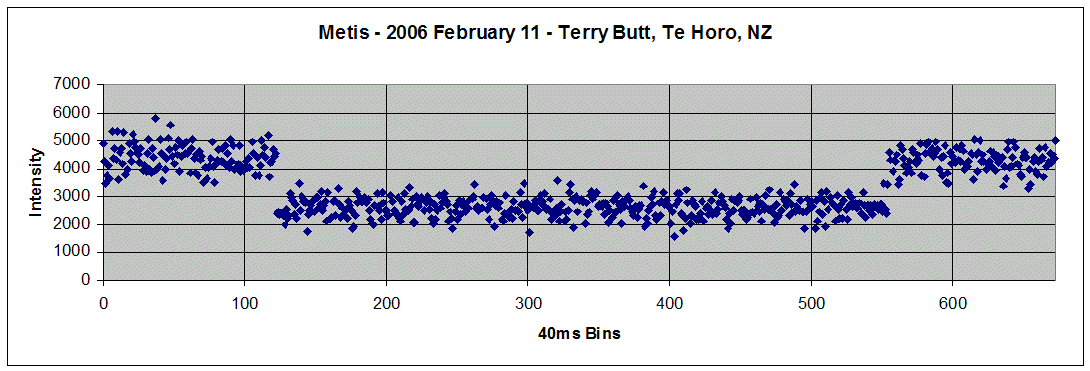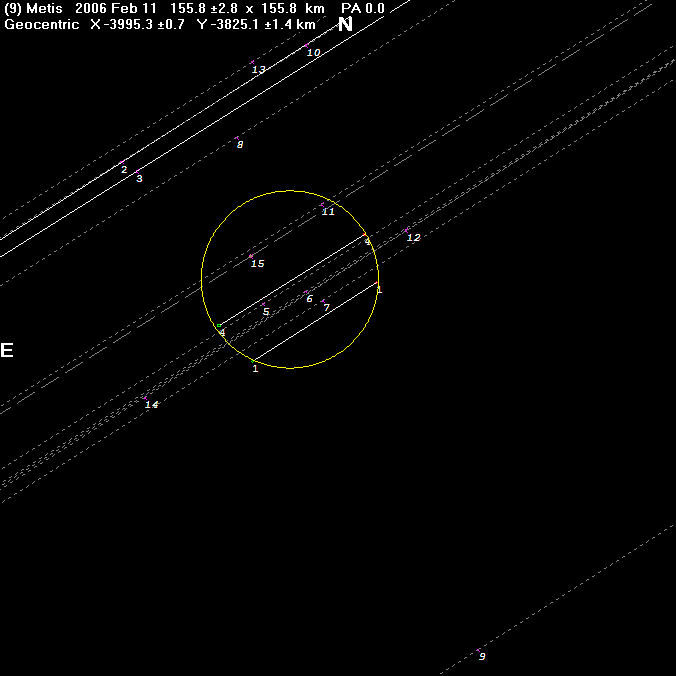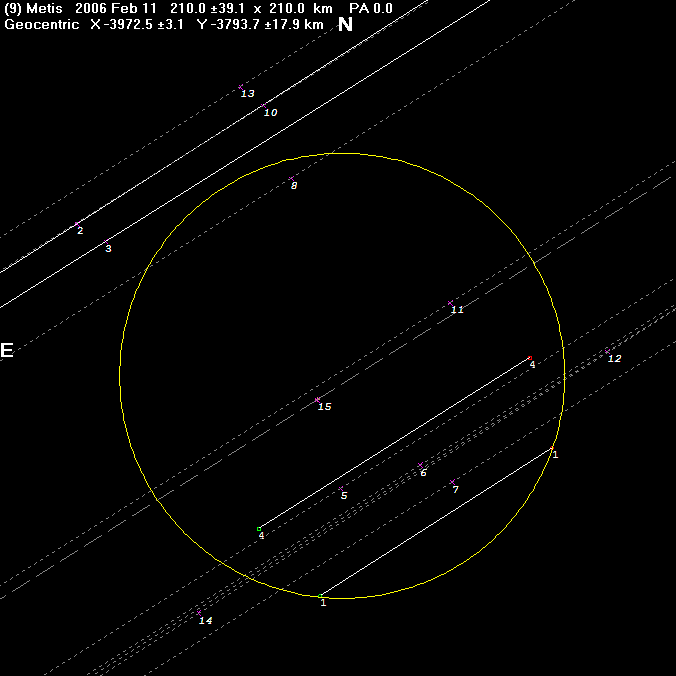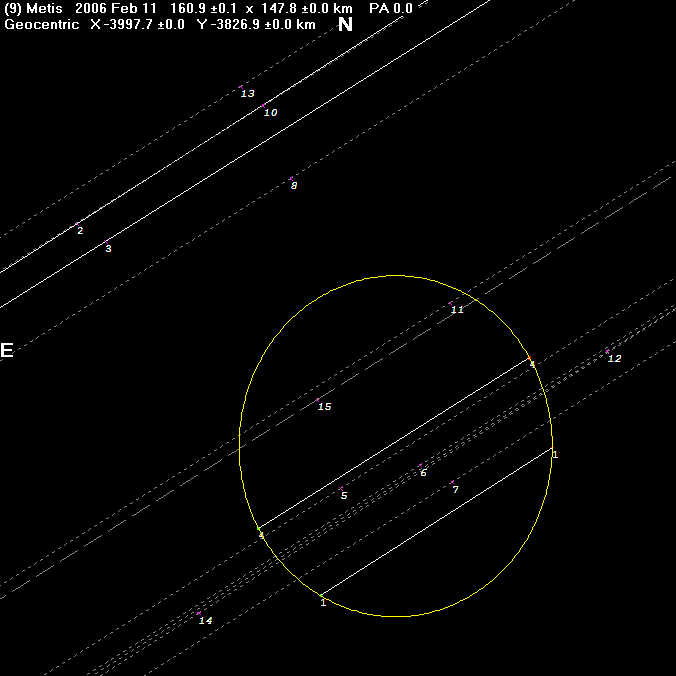A 14.8 second occultation was timed using the CCD drift-scan technique by John Broughton in Reedy Creek, Qld. A 17.26 second occultation was also timed by Terry Butt in Te Horo, NZ using video.
View the updated prediction.
Discussion:
John Broughton's CCD drift-scan image is displayed below:

Terry Butt's occultation data is shown below. Data points are at 40 ms intervals. It will be seen that both the D and R events were quite sudden.

Observers: 1 J. Broughton, Reedy Creek, Qld, Aust. 2(M) S.Kerr, Glenlee, Qld, Australia 3(M) K. Barker, Auckland, NZ 4 T. Butt, Te Horo, NZ 5(C) P. Graham, Martinborough, NZ 6(C) J. O'Kane, Upper Hutt, NZ 7(C) G.Blow/M.Forbes, Wellington, NZ 8(C) D. Brock, Hamilton, NZ 9(C) D. Gault, Hawkesbury Hgts, NSW, Austr 10(C) A. Walker, Te Puke, NZ 11(C) A. Dodson, Waitara, NZ 12(C) G. Hudson, Pukerua Bay, NZ 13(C) D. Watson, Whakatane, NZ 14(C) P. Anderson, Brisbane, Qld, Australia 15(P) Updated Prediction M = Miss C = Cloud

The above plot shows the relative locations of all the potential observers of this event (most of whom were
clouded out - as indicated by the dotted lines).
The dashed line #15 shows the central line of the path according to the updated prediction.
The circle represents the expected 210km diameter of Metis (assumed circular).
Discussion:
The plot below shows observers close to the asteroid's path in more detail, again with Metis plotted as a circle of 210 km diameter.

What is immediately clear is the number of observers who were unlucky to have missed seeing the event owing to cloud or other factors. While the two chords obtained are insufficient to derive a shape or exact diameter for Metis, it is also clear that they don't conform very well to a circle of 210 km.
Bearing in mind that attempting to fit an ellipsoidal shape will result in a large number of possible solutions, we have nevertheless allowed the major and minor axes to change, resulting in the representative plot below:

It is unfortunate that even one additional chord was not obtained for this event.
Observational Data:
Observer's Name : John Broughton
Aperture (cm) : 50.1 (25 equivalent used)
Focal length (cm) : 140
Type (e.g. SCT; Newtonian) : Newtonian
Magnification : CCD drift-scan, 4.1 pixels per second
Observing site name : Reedy Creek, Gold Coast
Longitude (East +ve) : +153 23' 49"
Latitude (South -ve) : -28 06' 36"
Height above Sealevel (metres) : 66
Geodetic Datum (e.g.WDD84,NZ1949): AGD66
Sky Transparency (Delete two) : Poor
Star Image Stability (Delete two): Fair
Other Conditions:
(Wind, Clouds, Lights, etc.): Bright moonlight and haze.
Time Source (e.g. WWV, VNG) : WWVH.
Recording method (e.g. tape) : Tape.
Could you see the Asteroid? : Only combined light monitored though
asteroid is visible during occultation.
Approx. Limiting Magnitude : 11
| Estimated |
Universal Time | Reaction | Accuracy, Remarks
h m s | Time (sec) |
Started Observing : 12:41:30.21 n/a 0.01
Disappearance At : 12:41:49.80 n/a 0.2
Reappearance At : 12:42:04.64 n/a 0.2
Stopped Observing : 12:42:30.66 n/a 0.01
Duration : 14.8
ADDITIONAL COMMENTS: CCD drift-scan. Measurements done with Scanalyser.
On the previous night, I positioned the telescope aided by my Scantracker software. That was necessary to
check line-of-sight for the event since the big scope cannot reach most azimuths below 30 degrees elevation.
An overcast sky meant I had to do a blind slew, accurate to about 2' barring any stepper motor stall.
Scantracker can also be used any time after halting the drive to predict when stars cross the field for
pointing confirmation, but under the conditions I never got the chance to do so.
With little expectation, CCD cooling was commenced 25 minutes before the event under a blanket of cloud.
It wasn't until 10 minutes to go when I noticed the sky in the direction of the event was improving by the
minute and fortunately a gap in the cloud arrived with 5 minutes to spare, lasting long enough for a usable
image to be acquired.
Often I can reach 15th magnitude but a reduced effective aperture of 25cm, bright moonlight and fleeting haze
cut the limiting magnitude to 11. This and the small magnitude drop accounts for the measurement accuracy
of 0.2 being relatively poor compared to previous results.
Observer's Name : Terry Butt
Aperture (cm) : 250
Focal length (cm) : 1600
Type (e.g. SCT; Newtonian) : SCT
Magnification : ?
Observing site name : Te Horo
Longitude (DD MM SS ; East +ve) : 175 07 26.53 E
Latitude (DD MM SS ; South -ve) : 40 48 47.31 S
Height above Sealevel (metres) : 52
Geodetic Datum (e.g.WGS84,NZ1949): WGS84
Height Datum (if known) : MSL
Sky Transparency (Delete two) : Good
Star Image Stability (Delete two): Fair
Time Source (e.g. WWVH, GPS) : Kiwi OSD
Recording method (e.g. tape) : VCR
Could you see the Asteroid? : No
Approx. Limiting Magnitude :
| Estimated |
Universal Time | Reaction | Accuracy, Remarks
h m s | Time (sec) |
COLUMN FORMAT TO USE---> __:__:__._ _._ _________________)
Disappearance At : 12:37:13.409 +/- 10 ms
Reappearance At : 12:37:30.669 +/- 10 ms
Duration : 17.26 sec
ADDITIONAL COMMENTS: None